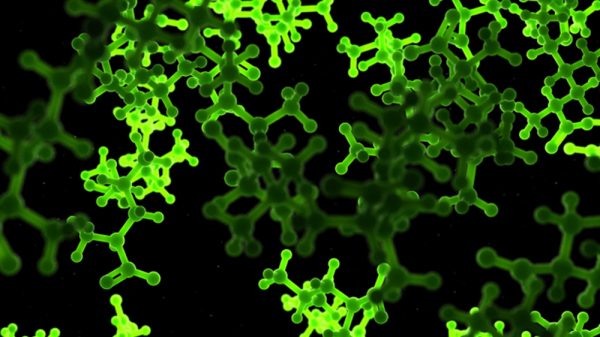You may have heard about amino acids. But did you know that there are different kinds of amino acids? Two major categories of amino acids are essential amino acids and nonessential amino acids. Keep reading to find out the difference between essential and non-essential amino acids, and learn which ones you need to incorporate into your diet on a daily basis.
What Are Amino Acids, Anyways?
Before we get into the different types of amino acids, let’s first examine what an amino acid is in general.
An amino acid is the smallest measurable component of protein. If you recall any lessons from high school biology class, you may be familiar with amino acids as the “build blocks of protein.” Amino acids can be compared to materials used to build a house. Materials like wood, stone, and brick can be used in a variety of arrangements to create a structure that suits a homeowner’s needs.
Similarly, amino acids with different properties can be attached to form proteins. While all amino acids contain an amide and carboxyl group, each amino acid has a side chain or R group of unique chemical composition. These R groups determine the chemical properties and behavior of the amino acids.
Amino acids are responsible for creating four protein structures that build upon each other: primary, secondary, tertiary, and quaternary. The primary structure of proteins refers to the chain of amino acids called a polypeptide chain. The secondary structure of proteins is the interaction of polypeptides to form shapes called alpha helices or beta sheets.
Tertiary structures are a bit more complicated and describe the three-dimensional shape formed by the alpha helices or beta sheets. The tertiary structure of a protein varies based on the protein’s function.
Finally, the quaternary structure of proteins describes a combination of two polypeptide chains to form a sort of protein conglomerate. The quaternary structure contrasts with tertiary structures, which are made of just one polypeptide chain.
Examining the Difference Between Essential and Non-Essential Amino Acids
To better understand essential amino acids, non-essential amino acids, and the difference between them, let’s examine each type of amino acid separately.
What Are Essential Amino Acids?
Essential amino acids are those amino acids that the human body requires from food on a daily basis. The human body is unable to synthesize essential amino acids internally. As a result, we must obtain all essential amino acids from our nutrition every day. Beyond simply getting all essential amino acids, the human body also requires essential amino acids in optimal ratios to support optimal health and functioning.
So, what are the names of the nine essential amino acids? The nine essential amino acids include leucine, isoleucine, valine, lysine, histidine, phenylalanine, tryptophan, methionine, and threonine.
Because essential amino acids are regarded as nutritionally necessary nutrients, they are also referred to as indispensable amino acids.
What Are Nonessential Amino Acids?
Unlike essential amino acids, nonessential amino acids are not required through the foods that we eat. The body can synthesize nonessential amino acids endogenously, which means that we don’t necessarily need to acquire them from the food that we eat. The human body can produce all the nonessential amino acids necessary for daily functioning.
The nonessential amino acids include amino acids like glycine, proline, glutamine, asparagine, glutamic acid, aspartic acid, ornithine, and aspartate.
Because nonessential amino acids are not required in the foods we eat, they are also referred to as dispensable amino acids.
Conditionally Essential Amino Acids
Since we’ve talked about both essential and nonessential amino acids, let’s quickly go over what it means if amino acids are described as conditionally essential. Conditionally essential amino acids – also known as conditional amino acids – are only required from dietary sources under certain circumstances. For example, some conditionally essential amino acids become nutritionally necessary during periods of stress.
Demand for Essential Amino Acids Increases Under Certain Circumstances
While we need essential amino acids on a daily basis, there are certain circumstances in which the body requires more essential amino acids than usual. For example, when you have been injured or have undergone surgery, the body is in a state of physical stress and must work hard to repair and damage. During this time, essential amino acids are being used up at a more rapid rate than usual. Therefore, in order to support the healing and recovery process, getting more essential amino acids than usual during this time is critical.
Why Are Essential Amino Acids Important?
We’ve talked a great deal about the fact that we require essential amino acids in optimal ratios on daily basis, but what exactly is the role of essential amino acids in the body? It turns out that essential amino acids play numerous roles in the body.
Here are just a few of the processes in which essential amino acids are involved and contribute significantly to human health and functioning.
- Muscle synthesis: All essential amino acids are needed in optimal ratios for the body to synthesize muscle tissue. Especially following a workout, after muscles are challenges, muscle fibers are damaged and must rebuild. Essential amino acids are the raw materials needed for muscle synthesis.
- Maintaining muscle mass: In addition to synthesizing muscle tissue, essential amino acids are vital for simply maintaining muscle mass. The amino acids that make up muscle turn over every 24 hours and must be replaced with fresh amino acids. Getting optimal ratios of essential amino acids daily is vital for supporting ideal body weight and body composition.
- Building neurotransmitters: Essential amino acids like tryptophan and phenylalanine serve as raw materials in the production of neurotransmitters such as serotonin. Serotonin plays a particularly important role in regulating mood and sleep-wake cycles, which significantly impact our well-being.
- Supporting healing and repair: Following an injury or surgery, the immune system must work hard to repair damaged tissues. Essential amino acids provide the raw materials to rebuild these damaged tissues.
Food Sources of Essential Amino Acids
Here we focus on ways to get all of the essential amino acids that you need on a daily basis. The quality of protein sources is often measured by a score called the protein digestibility-corrected amino acid score (PDCAAS), which assesses both the bioavailability of protein and the essential amino acid content. When the PDCAAS is measured at 1, the protein source is ideal for human health and contains optimal ratios of essential amino acids that humans need. When the PDCAAS is less than 1, this indicates that the protein source does not contain all essential amino acids in optimal ratios to support human health. The closer a PDCAAS is to 1, the higher-quality the protein source is. Conversely, the closer a PDCAAS is to 0, the lower-quality the protein source is.
Animal Sources
The best food sources of essential amino acids include animal proteins. Animal proteins like meat, dairy, and eggs all contain optimal ratios of essential amino acids, and all animal protein products have a PDCAAS of 1. However, to look out for your health, it’s important to choose the right kinds of animal proteins. Steer clear of any animal proteins that have been heavily processed or filled with ingredients like saturated fat and salt that can lead to clogged arteries and high blood pressure over time.
Here are a few examples of the best animal sources of protein:
- Chicken and turkey breast: Light meat like chicken and turkey breast is very low in fat while also containing optimal ratios of essential amino acids.
- Fish: Not only is fish high in protein and essential amino acids, but it is also a rich source of omega-3 fatty acids, which exerts potent anti-inflammatory properties on all organ systems.
- Low-fat cheese: Low-fat cheese is an excellent source of protein and essential amino acids. Make sure to choose a cheese that is both low in saturated fat and sodium. Soft cheeses like mozzarella and ricotta tend to be the healthiest cheeses.
- Eggs whites: Egg whites are very healthy, low-fat protein sources. Avoid the egg yolk when possible, simply because it contains more cholesterol and fat.
Here are a few examples of animal protein sources to stay away from:
- Processed meats: Processed meats like pepperoni, salami, and sausage tend to be packed with saturated fat and sodium that can drive up cholesterol levels and blood pressure.
- Red meat: Red meat is generally packed with saturated fat and is known to drive up inflammation levels.
- Deli meats: Though deli meats are delicious in a sandwich, they are generally highly processed and filled with salt and preservatives.
Plant Sources
Plant sources of protein also provide essential amino acids, though not in optimal ratios. Nearly all plant sources of proteins are incomplete proteins, meaning they are missing at least one essential amino acid. The PDCAAS of each plant protein source is less than 1, though the plant protein with the highest PDCAAS (about 0.9) is soy protein.
The missing amino acid in plant proteins is also known as the limiting acid. When even one essential amino acid is missing, the body cannot normally carry out muscle synthesis, enzyme production, and other biological processes. Missing one essential amino acid slows down all physiological processes, which underscores why all essential amino acids are needed in optimal ratios. Proteins that are missing essential amino acids are called incomplete proteins.
What are some good plant protein sources? Here are a few examples.
- Soy protein: Soy protein in the form of soybeans, tofu, or tempeh, is the form of plant protein closest to being complete. Soy protein is an extremely healthy protein source.
- Nuts and seeds: Nuts and seeds are major sources of protein in the plant-based diet. In addition, nuts and seeds also contain tons of antioxidants such as lignans as well as fiber, and healthy fats.
- Beans: Beans are rich in fiber, vitamins, and minerals, as well as protein. Excellent choices of beans that contain lots of protein include black beans, chickpeas, cannellini beans, kidney beans, and black-eyed peas.
- Whole grains: You may think of whole grains as primarily a carbohydrate source. But did you know that whole grains also contain lots of protein? Whole grains retain the original plant’s hull, which is packed with protein, fiber, and antioxidants.
Supplements
Supplements are available to provide you with balanced ratios of essential amino acids. While it’s possible to get plenty of essential amino acids in balanced ratios from your diet, incorporating an essential amino acid supplement into your daily routine can help eliminate any guesswork when it comes to making sure that you’re getting essential amino acids and not small ratios. The best essential amino acid supplements are those that contain no added sugars and are low in calories.
Benefits of Essential Amino Acid Supplements
Essential amino acids can be obtained through the diet. However, essential amino acid supplements provide many surprising benefits.
Here are a few ways in which supplementation may be a superior way to obtain essential amino acids, instead of only through food.
Digestion
Essential amino acid supplements are really important for digestion. So, why is this? Hope protein particles are notoriously challenging for the digestive system to process. When we eat protein, we first have our mouth and teeth perform mechanical digestion, which means physically breaking down protein into smaller particles. However, the bonds within the polypeptide chains have not been broken. This first stage of digestion is only physical. Then protein particles progressed through the stomach and small intestines where are they are chemically broken down into individual amino acids. Once the protein has been broken down into individual amino acids, these amino acids are then absorbed into the bloodstream. They are then are shuttled throughout the body for use in various biological processes.
Unlike whole protein particles, essential amino acid supplements already contain individual amino acids in their pure form. This negates the need for using lots of energy to digest protein. Essential amino acid supplements are easy on the stomach, making them ideal for individuals who have just undergone stomach surgery or any other kind of procedure that jeopardizes digestive power.
Elderly Individuals
Elderly individuals generally have more trouble processing food and proteins that are hard to digest. The digestive systems of older adults don’t function as smoothly as the digestive systems of younger adults. On top of that, elderly individuals experience sarcopenia, which is the loss of muscle mass over time. To maintain muscle mass, elderly adults must consume adequate levels of essential amino acids, which can be difficult if digestive processes are compromised. As a result, older adults generally do not get the protein they need and face muscle wasting, causing their health and quality of life to deteriorate. Essential amino acid supplements that are easy to digest are perfect for helping elderly individuals preserve muscle mass and reduce injury risk.
Following a Restricted or Plant-Based Diet
Strict vegan and plant-based diets don’t automatically contain all the essential amino acids that you need for the body to function optimally. Instead, vegan and plant-based diets must be planned out carefully to ensure that a variety of plant proteins are consumed throughout the day. However, the normal chaos of life can make it difficult to properly plan out all protein sources for the day.
Similarly, individuals with severe food allergies, restricted diets, or extreme food aversions may face similar challenges in incorporating sufficient amounts of protein and essential amino acids into their diets. For any of these individuals, a high-quality essential amino acid supplement can ensure that there are no limiting amino acids or gaps in their diets.
How Much of Each Essential Amino Acid Should You Be Getting Each Day?
It’s probably not completely necessary to count out how much of each essential amino acid is necessary to consume on a daily basis. Eating a well-rounded diet and/or supplementing with a high-quality essential amino acid supplement is enough to eliminate guesswork and ensure that you’re getting the amino acids you need to thrive.
However, if you are interested in the essential amino acid requirements and how they vary by age and gender, the USDA has put together with dietary reference intakes for how much of each nutrient the human body needs. (1)
Conclusion
The difference between essential and nonessential amino acids boils down to whether or not the amino acids are required from dietary sources. Regardless of conditions, essential amino acids are indispensable to optimal human functioning and therefore must be consumed in balanced ratios daily. Any single animal protein source naturally contains ideal ratios of essential amino acids. In contrast, plant proteins must be combined over the course of the day to provide ideal ratios of essential amino acids.

References:
(1) https://www.nal.usda.gov/sites/default/files/fnic_uploads/energy_full_report.pdf























